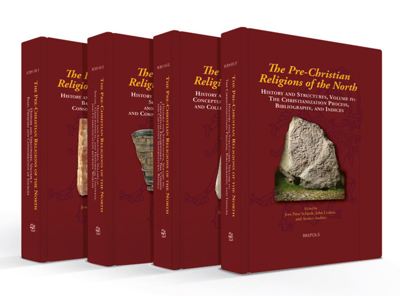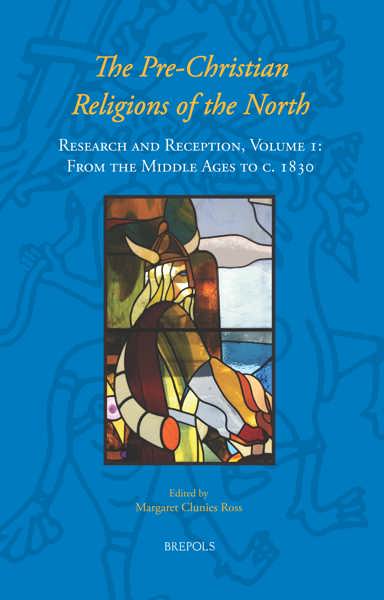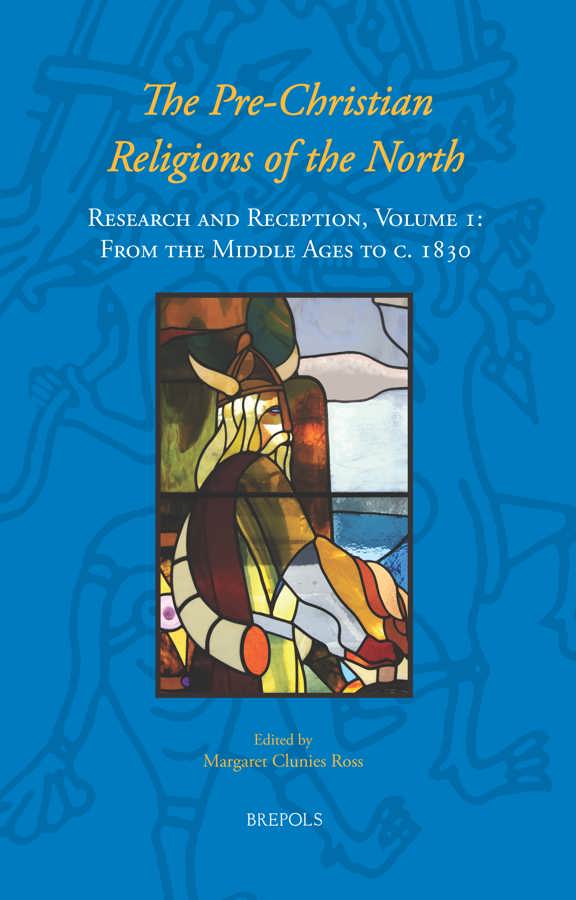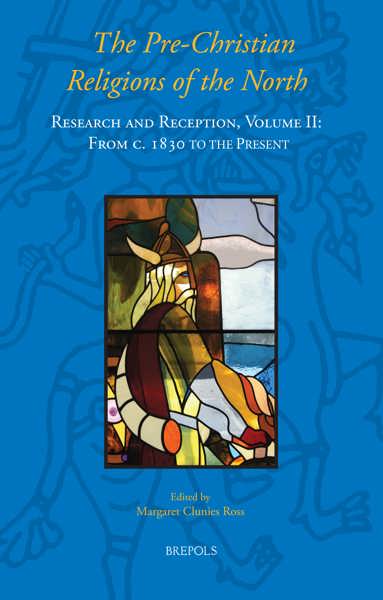
The Pre-Christian Religions of the North
Research and Reception, Volume I: From the Middle Ages to c. 1830
Margaret Clunies Ross (ed)
- Pages: xxxiv + 637 p.
- Size:156 x 234 mm
- Illustrations:37 b/w, 24 col.
- Language(s):English, Old Norse
- Publication Year:2018
- € 145,00 EXCL. VAT RETAIL PRICE
- ISBN: 978-2-503-56879-9
- Hardback
- Available
- € 145,00 EXCL. VAT RETAIL PRICE
- ISBN: 978-2-503-56881-2
- E-book
- Available
This book reveals the various ways people have understood or reacted to Scandinavian paganism from the Middle Ages to today.
“This volume, like the larger project to which it pertains, is remarkable for its comprehensive vision (…) This volume represents a real achievement, and scholars of pre-Christian religions, or indeed any religion, should take note. In unpacking approximately a millennium's worth of historiographical baggage--and indeed, in volume II's promise to take matters up to the present day--this book does not free us from the weight of past interpretations, but rather engenders a greater awareness of all the historically contingent factors which have influenced past reception, and which continue to influence reception (scholarly and otherwise) today. I recommend it most warmly.” (Ingrid Rembold, in The Medieval Review, 180904)
“There is no doubt that The Pre-Christian Religions of the North is a substantial scholarly achievement, situated as it is in a research project that promises eight hefty volumes that trace an academic field from its inception to the present and will provide a springboard for many further projects. It is an exciting study indeed. Margaret Clunies Ross and her team of authors deserve praise, and the book merits a wide readership. It is warmly recommended.” (Carole M. Cusack, in Parergon, 35/2, 2018, p. 205)
“Overall, this volume is a well-balanced collection of illuminating chapters. Particularly impressive is the survey of the reception of Norse myth in the) visual arts, which seem no less stunning today. It will likely be of great interest to established scholars, across many disciplines, and students alike.” (Manu Braithwaite-Westoby, in NUMEN, 68, 2021, p. 92-93)
“This book and its accompanying second volume deserve the attention of anyone interested in the historical development of Old Norse/Icelandic studies. But they should indeed be available in any library supporting serious research on the historical development of European culture, and on medievalism.” (John Kennedy, in Journal of the Australian Early Medieval Association, 16, 2020, p. 214)
Over more than a thousand years since pre-Christian religions were actively practised, European – and later contemporary – society has developed a fascination with the beliefs of northern Europe before the arrival of Christianity, which have been the subject of a huge range of popular and scholarly theories, interpretations, and uses. Indeed, the pre-Christian religions of the North have exerted a phenomenal influence on modern culture, appearing in everything from the names of days of the week to Hollywood blockbusters. Scholarly treatments have been hardly less varied. Theories – from the Middle Ages until today – have depicted these pre-Christian religious systems as dangerous illusions, the works of Satan, representatives of a lost proto-Indo-European religious culture, a form of ‘natural’ religion, and even as a system non-indigenous in origin, derived from cultures outside Europe.
The Research and Reception strand of the Pre-Christian Religions of the North project establishes a definitive survey of the current and historical uses and interpretations of pre-Christian mythology and religious culture, tracing the many ways in which people both within and outside Scandinavia have understood and been influenced by these religions, from the Christian Middle Ages to contemporary media of all kinds. The present volume (I) traces the reception down to the early nineteenth century, while Volume II takes up the story from c.1830 down to the present day and the burgeoning of interest across a diversity of new as well as old media.
- Acknowledgements
- Abbreviations
- The Authors
- List of Illustrations
- Plates
Part 1 Looking In: The non-Scandinavian Perspective
- 1.0 Introduction to Part 1 —MARGARET CLUNIES ROSS
- 1.1 Pictured by the Other: Classical and Early Medieval Perspectives on Religions in the North —HENRIK JANSON
- 1.2 Anglo-Saxon Responses to Scandinavian Myth and Religion —PHILIP A. SHAW
- 1.3 Finno-Ugric Neighbours —THOMAS DUBOIS
- 1.4 Celtic-Scandinavian Contacts —BERNHARD MAIER
- 1.5 The Reception of early Nordic Religions and Myths in Old Rus’ —VLADIMIR JA. PETRUKHIN AND TATJANA JACKSON
- 1.6 The Reception in early Arabic writings—JAN RETSÖ
Part 2 The View from Inside: the Medieval Scandinavian Reception
- 2.0 Introduction to Part 2—MARGARET CLUNIES ROSS
- 2.1.1 The Learned Prehistory and Natural Religions —MATS MALM
- 2.1.2 The Tower of Babel and the Diffusion of World Languages and Religions—ANNETTE LASSEN
- 2.1.3 Demonism and the pre-Christian Gods of Scandinavia—MARGARET CLUNIES ROSS
- 2.1.4 Remnants of Indigenous Beliefs in the Other World in Saga Literature—ÁRMANN JAKOBSSON
- 2.2.1 The Medieval Reception of Eddic Poetry with Mythological Subjects—ANNETTE LASSEN
- 2.2.2 The Reception in skaldic poetry and Snorri Sturluson’s Skáldskaparmál —MARGARET CLUNIES ROSS
- 2.2.3 The Reception in Medieval Historiography—ANNETTE LASSEN
- 2.2.4 The Reception in Saga Literature —MARGARET CLUNIES ROSS
Part 3 The Humanist Reception
- 3.1 The Humanist Reception in Scandinavia —MATS MALM
- 3.2 Icelandic Humanism —ANNETTE LASSEN
Part 4 The First Period of International Reception: From Humanism to the Romantics
- 4.1. Myth and Religion in the Enlightenment and Pre-Romantic Period —MARGARET CLUNIES ROSS
- 4.2 Pre-Christian Religions of the North and the Political Idea of Liberty—JULIA ZERNACK
- 4.3 The New Aesthetics and the Concept of the Sublime MARGARET CLUNIES ROSS
- 4.4 Dalin, Ramsay, and the Enlightened Reaction to Rudbeckianism —LARS LÖNNROTH
- 4.5 A Key Work for the Reception History of Norse Mythology and Poetry: Paul Henri Mallet’s History of the Danish Empire and its European Impact —JULIA ZERNACK
Part 5 The Romantics
- 5.1. Images and Imageries of Norse Mythology in German Sentimentalism and Romanticism: From Herder to Heine —SERGEJ LIAMIN
- 5.2 Ewald’s and Oehlenschläger’s Poetry inspired by Old Norse Myth—LISE PRÆSTGAARD ANDERSEN
- 5.3 Swedish Romanticism and Gothicism: Aesthetic Synergies —MATS MALM
- 5.4 The Norwegian Reception during the late Eighteenth and early Nineteenth Centuries—JAN RAGNAR HAGLAND
- 5.5 Old Norse Myths and Icelandic Romanticism —SVEINN YNGVI EGILSSON
- 5.6 English Romanticism and Norse Mythology —HEATHER O’DONOGHUE
- 5.7 The ‘Nordic Renaissance’ in Russia and Poland —JULIA ZERNACK
- 5.8 The International Reception of a Seminal Work: Baldrs draumar —JULIA ZERNACK
Section 6.1 Drama
- 6.1.1 Early Representations of Old Nordic Religions in Drama —TERRY GUNNELL
Section 6.2 Painting and Sculpture: Classical versus Norse Mythology
- 6.2.1 Painting and Sculpture in Denmark —BO GRANDIEN
- 6.2.2 Painting and Sculpture in Sweden—BO GRANDIEN
- 6.2.3 Painting and Sculpture in Norway —BO GRANDIEN
- 6.2.4 Painting and Sculpture in Germany c.1750 to the Early Twentieth Century —SARAH TIMME
- 6.2.5 The Visual Arts in Britain—MARGARET CLUNIES ROSS
Part 7 Enabling Philology
- 7.1 Enabling Philology: Essential Preconditions for a Scholarly Reception of the Pre-Christian Religions of the North—MARGARET CLUNIES ROSS
Part 8 The Early Grundtvig
- 8.1 N. F. S. Grundtvig: The Æsir Intoxication and Nordens mytologi (1808) —FLEMMING LUNDGREEN-NIELSEN
Index of Authors, Artists and Works (pre-1900)
Index of Concepts (including names and concepts from Nordic Pre-Christian myth)


